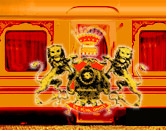Here we list some of the most important and famous Churches of Goa
Churches of Goa
The Church of St. Francis Xavier in Goa
Behind the gate of St. Paul's college is a Kuchcha road branching off the main road, leading to the chapel of St. Francis Xavier. It is built of laterite plastered with lime mortar; with tiled roof supported by wooden rafters is a plain chapel with only one altar.
Church of the Carmelites in Goa
Nothing remains of the Church of the Carmelites excepting the façade and a raised pavement, which served as an altar. Its location is to the southeast of the Church of St. Cajetan and is on a hill more or less contiguous to the hill on which the Chapel of Our Lady of the Mount stands.
Se Cathedral Church in Goa
The Portuguese Viceroy Redondo commissioned the Se, or St. Catherine's' Cathedral, southwest of St. Cajetan's, to be "a grandiose church worthy of the wealth, power and fame of the Portuguese who dominated the seas from the Atlantic to the Pacific". Today it stands larger than any church in Portugal, although it was beset by problems, not least a lack of funds and Portugal's temporary loss of independence to Spain. It took eighty years to build and was not consecrated until 1640.
The Chapel of Our Lady of the Mount in Goa
As one proceeds, about 2-km on the main road towards Ponda, a Kuchcha road branches off towards north at a place where a cross is fixed. The road leads to a hill on which, commanding a picturesque view, is the Chapel of Our Lady of the Mount. A series of steps leads to the Chapel, which is built of laterite plastered with lime mortar. It has three main altars dedicated respectively to our lady of the mount, St. Anthony and St. Andrew.
The Chapel of St. Catherine in Goa
Further to the west of the Church of St. Francis of Assisi is the chapel of St. Catherine. Built of laterite blocks it has a tower on either side of the façade. The chapel in the interior, having only one altar is plain.
The Church Of Our Lady of the Rosary, Goa
Not far to the west of the Basilica of the Bom Jesus is the Holy Hill at the extremity of which is the Church of Our Lady of the Rosary. Built of laterite and plastered with lime mortar, it has a two-storied portico. The portico as well as the façade of the church has rounded towers on either side with the cross on top. The roof of the church is tiled, supported by wooden rafters.
The Church Of St. Cajetan, Goa
Opposite the Se Cathedral, beyond the road is the large and beautiful church of St. Cajetan built of laterite blocks, which were lime plastered. The façade, having two towers on either side to serve as belfry, has Corinthian columns and pilasters supporting a pediment, and four niches in which are kept the statues of the apostles.
The Convent and the Church Of St. John of God, Goa
Situated to the east of the tower of St. Augustine it is a plain looking building constructed in the beginning of the 18th century. The convent was abandoned in 1835. The Society of the Misericordia occupied it for some time.
The Church and Convent of St. Monica, Goa
In the Holy Hill, on the way to the Church of Our Lady of the Rosary, is a huge three-storied building of laterite which was originally lime-plastered but is now plastered with cement. It is square on plan with a large inner courtyard, around which is a cloistered verandah and numerous cells and halls. The vaulted ceilings in some of the halls are tastefully painted with floral decorations and scenes from the Holy bible.
The Convent and the Church of the Cross of Miracle, Goa
On the southern outskirts of Old Goa is a hill on which stand this convent and church. Built of laterite, plastered with lime mortar, the plain looking church and the single storied convent with numerous cells are now in ruins. A church, specially built in 1619 to house the Cross of Miracles, having crumbled, the present church was built on the same spot in 1674.
The Professed House and the Basilica of Bom Jesus, Goa
Immediately to the south of the main road is the Professed House, a two-storied laterite building covered with lime plaster. Despite the opposition, which the Jesuits faced, the building was completed in 1585. A part of the building was accidentally burnt down in 1663 and was rebuilt in 1783.
The Convent and Church Of St. Francis of Assisi, Goa
To the west of the Se Cathedral is the former palace of the Archbishop that connects the Se Cathedral to the Convent and Church of St. Francis of Assisi. The structure is built of laterite blocks and is lime-plastered. The church faces west and has a nave with three chapels on side, a choir, two altars in the transept and a main altar. To the north of the main altar are a belfry and a sacristy. The convent, which forms an annexure to the church, now houses the Archaeological Museum.
The Royal Chapel of St. Anthony, Goa
To the west of the tower of St. Augustine is the Royal Chapel dedicated to St. Anthony, the national saint of Portugal and held in great veneration by the Portuguese. It was built in the beginning of the 17th century.
Ruins of St. Augustine's Tower in Goa
Built in 1602, the only ruin of the Church of St. Augustine on the Holy Hill at Old Goa near the Nunnery is a lofty 46-metre high tower defying the torrential rains. The tower is one of the four of St. Augustine Church that once stood there. There were eight richly adorned chapels and four altars, and a convent with numerous cells and artistic columns attached to the church.
Behind the gate of St. Paul's college is a Kuchcha road branching off the main road, leading to the chapel of St. Francis Xavier. It is built of laterite plastered with lime mortar; with tiled roof supported by wooden rafters is a plain chapel with only one altar.
Church of the Carmelites in Goa
Nothing remains of the Church of the Carmelites excepting the façade and a raised pavement, which served as an altar. Its location is to the southeast of the Church of St. Cajetan and is on a hill more or less contiguous to the hill on which the Chapel of Our Lady of the Mount stands.
Se Cathedral Church in Goa
The Portuguese Viceroy Redondo commissioned the Se, or St. Catherine's' Cathedral, southwest of St. Cajetan's, to be "a grandiose church worthy of the wealth, power and fame of the Portuguese who dominated the seas from the Atlantic to the Pacific". Today it stands larger than any church in Portugal, although it was beset by problems, not least a lack of funds and Portugal's temporary loss of independence to Spain. It took eighty years to build and was not consecrated until 1640.
The Chapel of Our Lady of the Mount in Goa
As one proceeds, about 2-km on the main road towards Ponda, a Kuchcha road branches off towards north at a place where a cross is fixed. The road leads to a hill on which, commanding a picturesque view, is the Chapel of Our Lady of the Mount. A series of steps leads to the Chapel, which is built of laterite plastered with lime mortar. It has three main altars dedicated respectively to our lady of the mount, St. Anthony and St. Andrew.
The Chapel of St. Catherine in Goa
Further to the west of the Church of St. Francis of Assisi is the chapel of St. Catherine. Built of laterite blocks it has a tower on either side of the façade. The chapel in the interior, having only one altar is plain.
The Church Of Our Lady of the Rosary, Goa
Not far to the west of the Basilica of the Bom Jesus is the Holy Hill at the extremity of which is the Church of Our Lady of the Rosary. Built of laterite and plastered with lime mortar, it has a two-storied portico. The portico as well as the façade of the church has rounded towers on either side with the cross on top. The roof of the church is tiled, supported by wooden rafters.
The Church Of St. Cajetan, Goa
Opposite the Se Cathedral, beyond the road is the large and beautiful church of St. Cajetan built of laterite blocks, which were lime plastered. The façade, having two towers on either side to serve as belfry, has Corinthian columns and pilasters supporting a pediment, and four niches in which are kept the statues of the apostles.
The Convent and the Church Of St. John of God, Goa
Situated to the east of the tower of St. Augustine it is a plain looking building constructed in the beginning of the 18th century. The convent was abandoned in 1835. The Society of the Misericordia occupied it for some time.
The Church and Convent of St. Monica, Goa
In the Holy Hill, on the way to the Church of Our Lady of the Rosary, is a huge three-storied building of laterite which was originally lime-plastered but is now plastered with cement. It is square on plan with a large inner courtyard, around which is a cloistered verandah and numerous cells and halls. The vaulted ceilings in some of the halls are tastefully painted with floral decorations and scenes from the Holy bible.
The Convent and the Church of the Cross of Miracle, Goa
On the southern outskirts of Old Goa is a hill on which stand this convent and church. Built of laterite, plastered with lime mortar, the plain looking church and the single storied convent with numerous cells are now in ruins. A church, specially built in 1619 to house the Cross of Miracles, having crumbled, the present church was built on the same spot in 1674.
The Professed House and the Basilica of Bom Jesus, Goa
Immediately to the south of the main road is the Professed House, a two-storied laterite building covered with lime plaster. Despite the opposition, which the Jesuits faced, the building was completed in 1585. A part of the building was accidentally burnt down in 1663 and was rebuilt in 1783.
The Convent and Church Of St. Francis of Assisi, Goa
To the west of the Se Cathedral is the former palace of the Archbishop that connects the Se Cathedral to the Convent and Church of St. Francis of Assisi. The structure is built of laterite blocks and is lime-plastered. The church faces west and has a nave with three chapels on side, a choir, two altars in the transept and a main altar. To the north of the main altar are a belfry and a sacristy. The convent, which forms an annexure to the church, now houses the Archaeological Museum.
The Royal Chapel of St. Anthony, Goa
To the west of the tower of St. Augustine is the Royal Chapel dedicated to St. Anthony, the national saint of Portugal and held in great veneration by the Portuguese. It was built in the beginning of the 17th century.
Ruins of St. Augustine's Tower in Goa
Built in 1602, the only ruin of the Church of St. Augustine on the Holy Hill at Old Goa near the Nunnery is a lofty 46-metre high tower defying the torrential rains. The tower is one of the four of St. Augustine Church that once stood there. There were eight richly adorned chapels and four altars, and a convent with numerous cells and artistic columns attached to the church.
| Goa Travel: |
|---|
| Arts & Crafts of Goa | Beaches of Goa | Goa Carnival | Churches of Goa | Cities of Goa | Culture of Goa | Fairs & Festivals in Goa | History of Goa | Shopping in Goa | Wildlife in Goa |





